This project was undertaken as coursework for assessment in the ‘CUASOU503 Develop Sound Designs’ Unit of Competancy, as part of the Advanced Diploma of Music Industry qualification at Melbourne Polytechnic.
The UnVoice In Campus Sounds
For this project we needed to create a Sound Installation in Ableton using “campus sounds” framed by a concept, narrative, idea or theory. I decided to play with the notion of the voices of the campus – including the UnVoice or the Uncanny Voice of the campus, with a speculative fiction idea of voices of the place (a former hospital) resonating both forwards and backwards in time – ghosts of the future and ghosts of the past.
In her book ‘Voicetracks: Attuning to Voice in Media and the Arts’ (MIT Press. Cambridge, Massachusetts, 2017.), sound artist and academic Professor Norie Neumark poses the idea of the unvoice, of unvoicing, of being unvoiced. (My WordPress autocorrect keeps changing the words to unveiled and unveiling, which is poignant to the visibility of women.)
“The figure unvoice … particularly speaks to me because it evokes an … un quality of voice, its uncanniness – the return of the undead? As writer and scholar Mark Fischer, aka k-punk, points out, the Derridean figure of haunting and the uncanny (unheimlich) resound together: “Haunt is a perfectly uncanny word, since like ‘unheimlich’ it connotates both the familiar-domestic and its unhomely double. Haunt originally meant ‘to provide with a home,’ and has also carried the sense of the ‘habitual’ (k-punk, 2006). In this sense, unvoice literally haunts its media, a reminder of how we habitually used to listen to a relationship that is no longer at ease here – uneasy as well as uncanny.” [1]Neumark, Norie. ‘Voicetracks: Attuning to Voice in Media and the Arts’, MIT Press, Cambridge, Massachusetts, 2017.
For my Sound Design Installation I decided to play with the permeable nature of memory and time and the notion of extra-sensory perception of the dying or the delirious and feverish and deeply troubled. While echoes of the past linger in the architecture – the quiet sad dereliction of the Aids Memorial Garden with the river bush sounds, the theatre that looks awfully like a crematorium and a morgue space, the awnings and doors clearly designed for ambulance use, the hospital squeak of the floors and the high gates with a gatehouse to secure every infectious patient from making a quite literal “outbreak” – and fill the present with reminders of mortality – what if these resonances also echoed backwards? The voices and music and overlapping din of practice rooms and studios and rehearsal spaces echoing back to the minds of the dying and fever-drenched who used to occupy these buildings?
A Sense of Place
Melbourne Polytechnic Fairfield Campus, where many of the music and sound production courses are based, is a beautiful campus set in seclusion and surprising isolation given the inner-suburban location. This is not an accident. The campus is the former location of the Fairfield Infectious Diseases Hospital, originally the Queens Memorial Infectious Diseases Hospital. The location between Merri Creek and the Yarra River creates natural barriers; one can only approach the campus on one road (unless using a bike or walking trail).
While there have been obvious efforts to mute the “institutional” hospital feel of the campus, at every turn in the architecture and fixtures (or places where fixtures used to be) the medical nature of the history linger. This creates a peripheral awareness of very different uses of the spaces, both in the comparative recent history in the 1980s and 1990s when HIV/AIDS research and treatment was a major undertaking at this facility and the title “Queen’s Memorial Hospital” was owned humorously by the community of patents [2]Fairfield Hospital, Under The Red Ribbon, http://undertheredribbon.com.au/vignettes/fairfield-hospital/ , and further into the distant past – from the Polio epidemics of the 1920s to 1950s, right back to the Spanish Infuenza epidemic of 1918.
People convalesced on the sheltered verandahs here. And people died painful deaths here. And people lingered in altered states of delirium and fever-dream. Right next door to this day, the southern part of the original hospital is still in use as The Victorian Institute of Forensic Mental Health, Thomas Embling Hospital – which treats the acutely mentally ill from the criminal justice system. There is a sense of over-lapping and parallel narratives, where very different modes of perception are unfolding.
And then there are the music students today filling the rooms and the outdoor environments with music and sound, overlapping different eras, echoing, resonating…
Source Recordings
I collected a range of different location recordings on campus, wondering about with a Tascam DR-100MKII Linear PCM Recorder and a Sennheiser ME66/K6 Supercardiod Shotgun microphone. The sounds I recorded included cafe sounds, sounds of the factory next door, traffic sounds on Yarra Bend Drive, sounds of the hospital-fitted air-conditioners, sounds of birds and of brushing past plants, sounds of horticulture students digging and shovelling, sounds of various rehearsals from the exterior of buildings (including Gamelan Ensemble, Georgian Choir, rock and pop ensembles). I also sourced sounds from studio recordings I had made within the campus, but made new and uncanny through processing – I made particular use of AudioSuite in Pro Tools 12 to process audio backwards. This was especially uncanny sounding on the Georgian Choir and Gamelan Ensemble recordings. The ideas of these inter-cultural sounds echoing back to a distant past where they had little context to frame them to ghosts of the past was a particularly romantic, ethereal and numinous notion.
I also included recordings of my own voice singing select phrases from the ghost ballad ‘The Unquiet Grave’ as I found it quite applicable to the theme and concept of Unvoice and Uncanny Voice, as well as the history of the Campus: how much human remains must linger in a place for it to be a grave? After attending Liquid Architecture/ the Melbourne International Film Festival event ‘Michel Chion: The Audio Spectator’ [3]Liquid Architecture, Michel Chion: The Audio Spectator, http://www.liquidarchitecture.org.au/program/michel-chion/ , and seeing and hearing how much of himself Michel Chion put into his sound art, I felt quite liberated to be a part of the work as one of the voices. I found the phrase “grow green, and spring up again” to be very evocative of the lushness of the carefully tended gardens here, and the creepy idea of voices or unvoices rising up like ghosts.
Initial Assemblage of Sound Collage
As I feel very “newb” and not skilled up in Ableton, I arranged elements and did some processing in Pro Tools 12, before exporting stems for import into Ableton.
MP3 of Partial Project, audio elements compiled in Pro Tools.
Constructing Instrument Rack and Drum Rack in Ableton
I then assembled my stems again in Ableton (this was only a partial success, due mostly to my still tentative skills using Ableton). The following two screenshots are of Ableton Session View of audio elements.
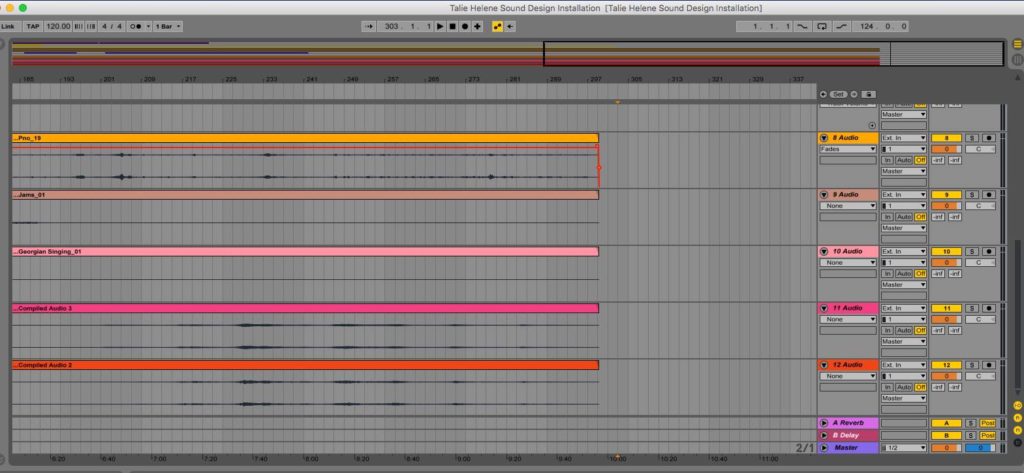
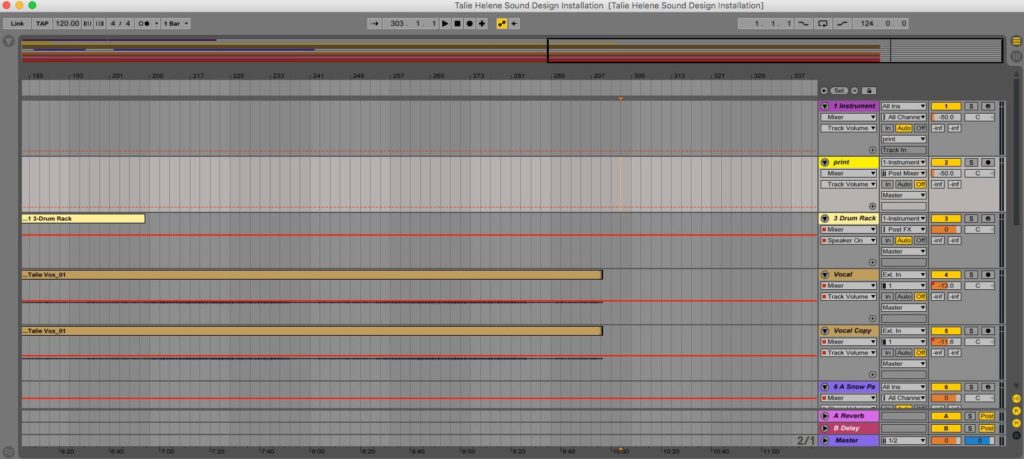
I created both an Instrument Rack and a Drum Rack as per our assessment brief requirements. I used the audio of various Campus Sounds elements from a Clip Library of original Sounds instead of “Loops” included with Ableton.
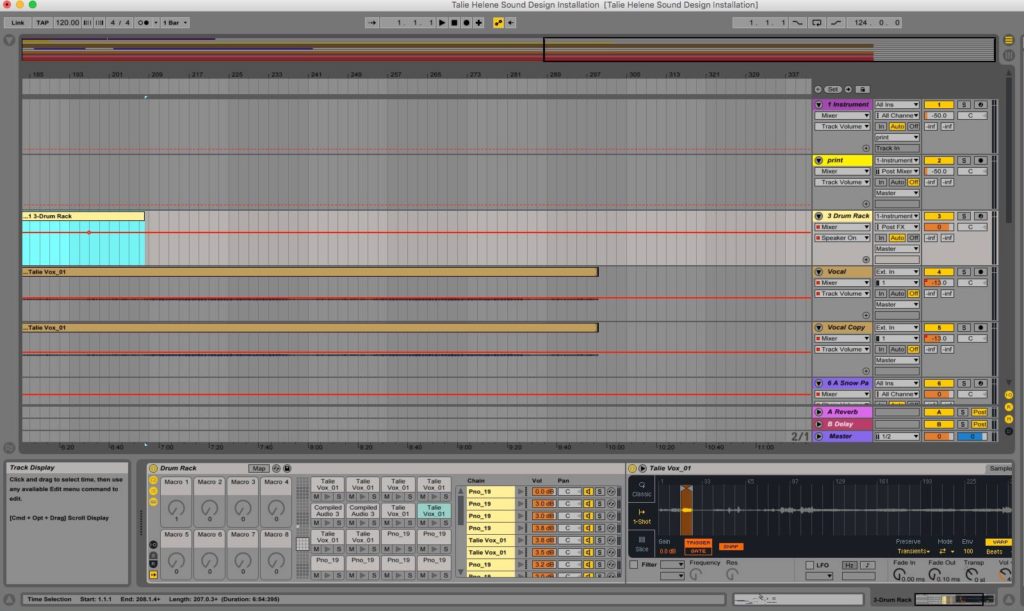
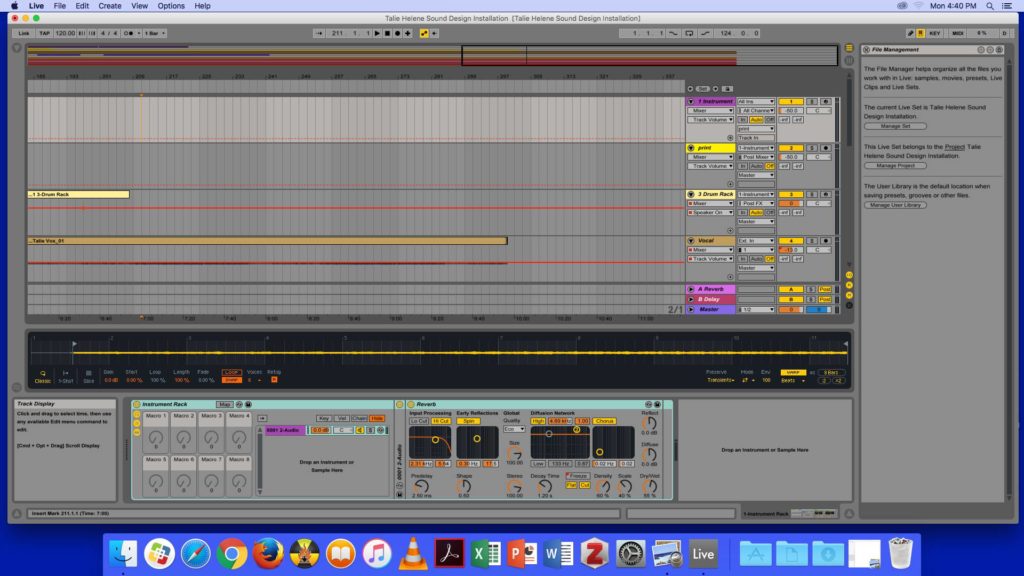
Once I had created the Instrument Rack and Drum Rack and included some processing, I played both of these “Live” and recorded the audio. This gives the Sound Installation a spontaneous and improvised quality. I very much treated this as an experiment, as I am learning about Ableton as an “instrument” each time I use it.
Unvoices of Yarra Bend
MP3 of final project:
In De-Brief
I did become slightly more proficient in using Ableton during this project, although I still identify many aspects where I am struggling to achieve even the most basic tasks of placing audio on a track (and Google the problem and get unhelpful advice or tutorials that require use as an Admin). It makes it hard to differentiate actual problems from mere logistics problems of using a lab computer, and I have not got a solid grasp of “Ableton 101” basics. For this reason, I applied to (and was accepted into) the Operator [4]Operator Event page, Arts Centre Melbourne, https://www.artscentremelbourne.com.au/event-archive/2017/the-channel/operator-ii short course at Arts Centre, which is affiliated with the Melbourne Ableton User Group. I have only attended one Operator class so far, but I am already beginning to appreciate some of the features that make Ableton unique – which also make it confusing and cumbersome if you come at it with the expectation that it is going to function like another DAW. I look forward to how my skills will be enhanced by taking a course more focused on basic Ableton operating skills, and where this may take my creativity in the future…
References
| ↑1 | Neumark, Norie. ‘Voicetracks: Attuning to Voice in Media and the Arts’, MIT Press, Cambridge, Massachusetts, 2017. |
|---|---|
| ↑2 | Fairfield Hospital, Under The Red Ribbon, http://undertheredribbon.com.au/vignettes/fairfield-hospital/ |
| ↑3 | Liquid Architecture, Michel Chion: The Audio Spectator, http://www.liquidarchitecture.org.au/program/michel-chion/ |
| ↑4 | Operator Event page, Arts Centre Melbourne, https://www.artscentremelbourne.com.au/event-archive/2017/the-channel/operator-ii |
This project was undertaken as coursework for assessment in the ‘CUASOU503 Develop Sound Designs’ Unit of Competancy, as part of the Advanced Diploma of Music Industry qualification at Melbourne Polytechnic.
Preamble
This blog post constitutes the presentation of the project; this mode of presentation is my preference over an in class presentation, as I wished to address issues that arose over the course of undertaking the project that would be difficult and stressful to consider in a verbal mode, and are more coherently addressed with the critical distance provided by a written and media presentation online. If you would like to leave a comment on the blog, you are welcome to do so.
Project Brief Summary
For this Audio Tour Project the students were given only one script to chose from to produce. The script that had been produced is a story about men, written by men, which includes the names of men, and the voices of men. The gender of the narrator is not specified in the brief, or the script, or the audio elements list. It is a violent colonial story that features only white men. I recommend that in future a number of scripts be produced for the students to chose from, that includes narratives that feature women and people from non-white colonial backgrounds in the stories, as this potentially alienates students from the project and it limits the voices that might be realistically employed in the production. If students have experience in writing for media and/or performance, I would suggest the student have an option of authoring their own script. (For example, I have trained in writing for radio with Steve Wheat, screen writing with Cathy Johnstone, and performance writing with Barry Dickins, and as such, I very likely may have more specialised expertise in this area than the teachers who created the script I am obliged to work from.)
The Project Brief
“Tourism Victoria is hosting an exhibition on the life of Ned Kelly at Glenrowan, in rural Victoria. As part of the exhibition, a sound design piece is to be implemented as a key element of the live event experience. As Tourism Victoria hosts a series of guided tours throughout the calendar year, the aim of this special event is to further enhance the regular ‘walk and talk’ guided tour by making it a more interactive experience for tourists. For this special event, a script has been produced, which contains 14 elements in total.
The sound design piece will be activated by tourism staff at the beginning of the ‘walk and talk’ tour. This will assist in ‘transporting tourists back in time’ and adding a touch of drama to the experience. Once played, the tour guide will lead tourists on a journey around the famous local landmarks where the actual events occurred. Your job is to sonically re‐create elements of the battle that took place between The Kelly Gang and the Police in Glenrowan. A combination of voice over narration and specific sound components have been chosen to best achieve this as a sound design piece. These will need to be assembled and mixed as stereo audio files in a DAW program.
Tourism Victoria staff will activate the playback of the sound design piece from a laptop at the exhibition site in Glenrowan. They will employ a stereo speaker set up for the installation at the venue. The event will incorporate lighting and image projection to further enhance the experience. These elements will be curated by the staff once the sound design is complete and delivered.
Consultation with your lecturer will be required to implement a successful sound design.” [1]Assessment 1 BRIEF, Created by Greg O’Shea, Martin Koszolko, February 2016, @Melbourne Polytechnic 2017.
Mock Client “Creative Director”
This project was designed with a very great deal of control and input given over to the teacher: “Your teacher will act as the ‘client’—as it were, a Creative Director. The Creative Director will have final approval over all elements of the sound design, including the voice talent and the recording of the script.”[2]Assessment 1 BRIEF, Created by Greg O’Shea, Martin Koszolko, February 2016, @Melbourne Polytechnic 2017.
The project specified that two voice-over artists needed to be sourced and recorded in “studio conditions” – this entailed “a quiet room and with a quality microphone. You may use additional signal processing, such as equalisation and compression.”[3]Assessment 1 BRIEF, Created by Greg O’Shea, Martin Koszolko, February 2016, @Melbourne Polytechnic 2017.
Voice Over Artist Recording & Production
The voice over of narrative for this Audio Tour is hands-down the most important auditory element. I extracted the text from the script so that it was presented as narration text only, in standard prose format of sentences and paragraphs with full punctuation. This was easier and more natural to read than the script, which was presented with all the audio element cues, both narration and sound design in a linear workflow.
I made a short booking at Toyland Recording Studio in Northcote, where I do some work as an intern engineer, and also communications and studio operations support work. I could not afford to pay a professional voice over artist for this project (although they frequent the studio often, as the studio produces many media productions for radio and other delivery formats.) Due to studio availability being limited (it is a working production facility), and the short length of the narration (less than one page), it was more efficient and achievable to record the entire voice overs with two contrasting voices – rather than record two partial voice overs and necessitate a second booking to re-record one of those in entirety.
Technical Specifications for Voice Over Recording
The studio “Room A” tracking room is quiet and has professional diffusion and reflection acoustic treatments to control the behaviour of sound waves advantageously for recording. The script was placed on a music stand with sconce light. The voice over artists wore fully enclosed headphones.
The microphone used in both voice overs is a Neumann m149 Tube Variable Duel Diaphragm Condenser microphone [4]https://www.neumann.com/?lang=en&id=current_microphones&cid=m149_description set to Cardiod Polar Pattern. The microphone was mounted on a (beautiful vintage) extra tall broadcast fixed boom stand, with plosive filter.
The signal flow was:
- Neumann m-149 Tube Condenser microphone >
- to Neve 1084 (1073 Mic Pres with expanded EQ sections) Pre-Amp >
- to Urei 1176 (Original – black front plate) mono limiter for Compression >
- to Nuendo 8 Digital Audio Workstation (DAW) environment.
The Neve 1084 EQ was adjusted to suit each voice. Two voice overs were recorded: a male friend did one reading, and I did the other reading (in my female mezzo soprano voice). My reading was done in less takes, and was deemed the stronger by both myself and my colleague, who has some thirty years production experience, including years as an advertisement producer for commercial radio. While he offered an opinion as mentor, with regards to engineering, he was totally hands off and all the decisions and implementation were left to me with: “You’re the engineer – what do your ears tell you to do?”
Voice Over Editing
Both voice overs were edited by myself in the same session, still in the DAW environment of Nuendo 8. The audio was monitored through Yamaha MSP10 Active 2 way studio monitors. Due to the high standard of the recording environment and quality of equipment in the signal flow the audio was not printed with noticeable background noise. Any hesitations or repetitions were edited to create a single coherent linear narrative. The voice-overs were “de-breathed”, plosives controlled, and mouth-sounds removed. A de-esser was employed and additional EQ applied using Fab Filter. No other processing was applied.
Listen to the edited male voice over here:
MP3: Male VO Audio Tour Project:
Listen to the edited female voice over here:
MP3: Female VO Audio Tour Project:
Voice Over Client Meeting/s
There was a reasonable expectation that the “mock Creative Director” would chose the best voice over based on reading quality for annunciation, intonation, and dramatic phrasing, given that no narration gender preference was specified in the brief. I left the session and attended the client consultation with the expectation that the teacher would select the female voice over, as it is in my estimation (and in the estimation of my veteran industry colleague) the stronger voice over.
To my very great surprise, the teacher hesitated on choosing a voice over, and asked to defer the decision until a later date. As far as I am aware, I was the only student to present voice overs in more than one gender choice (all the other students presented recordings of men), and the only student who had the voice over choosing postponed.
When I re-convened with the teacher, he asked me, “Can you use the voice over of your friend – for distance?”
This again really surprised me, as distancing the engineer from the project was not the role of the “Creative Director” – their role was to oversee the project for quality, and no gender preference had been included in the brief, nor instruction to not use one’s own voice (if I had known to organise a female friend to read, I would have done so).
Perhaps I should have objected to his voice over preference for the integrity of project quality – and it is easy to say in hindsight. But in real-time and face-to-face, I suffer the confidence gap, and I am not sufficiently far along with “Giving Up The Good Girl” socialisation – women are socialised to go along, be pleasant, and acquiesce. Girl’s cannot be OUTSTANDING, while we are still politely “being good”. It’s a massive learned behaviour to unlearn.
I felt (and I still feel) that the teacher revealed an unconscious bias towards a male voice narrating in a preconceived imagining in “the mind’s ear” of this Audio Tour (in this script written by men, about men, containing the names of only men, and now – the voices of only men) was problematic. Had I no means of comparison, I could hardly make a criticism – however, a means of comparison presented itself, as I sat in on the voice over presentation of a fellow student named James, who had also recorded the entire script, and had a male friend read the narration, and read the narration himself. Instead of being told to use his friend’s reading “for distance”, James was instructed to use his own voice, as it sounded “old fashioned and applicable to the project”.
James’s voice was not merely patriarchal-sounding, it was grand-fatherly sounding – the quintessential Aussie colonial bloke voice.
I felt this process of “distancing” me from the project, was distancing me from being invested and owning my own project, and it was being done to the detriment of my project overall quality. This sets one item on the Rubrik against the rest: “9. Seeks and responds positively to constructive feedback.” This grading criteria is an odd duck, as it implies all feedback received is equal, and also “constructive”. Teaching being an often imperfect process, some feedback may be biased and garbled and resembling helecopter-management, which requires a CRITICALLY INTELLIGENT response, but not necessarily a “positive” one. It kinds of puts the student in a bind.
This is what I’d describe as “a low grade problem” – which is to say in isolation, it isn’t such a big deal – but when you add it to the total load of “other stuff” in a very male dominated discipline, it most certainly adds to the culture in a way that is not positive or beneficial.
Unconscious Bias Towards Men’s Voices
It’s a thing!
“Meghan Sumner, an associate professor of linguistics at Stanford University, stumbled into the unconscious bias realm after years of investigating how listeners extract information from voices, and how the pieces of information are stored in our memory … Contrary to what many may think, unconscious bias is not a bias against one group, according to Sumner, but is the gap created from ‘the pulling apart of the two categories.’ She’s found that there’s not a negative bias against women. It’s just that when women are compared to men, they are downgraded while men are upgraded.” [5]Giang, Vivien. ‘How Unconscious Bias Is Affecting Our Ability To Listen’ Fast Company, 2016. https://www.fastcompany.com/3063218/how-unconscious-bias-is-affecting-our-ability-to-listen
If you’d like to go Down The Rabbit Hole, exploring the bias towards men’s voices and against women’s voices impacts on everything from politics, to podcasting, from professional voice over representation to representation in board rooms, here are some links to explore:
- Changing the Game podcast, Episode 42: The Unconscious Bias Against Women’s Voices, Nolan, Samantha.
- Making our voices heardMeghan Sumner investigates the gender dynamics of voice processing, Magliozzi, Devon. Gender News, The Clayman Institute for Gender Research, Stanford University, 2015.
- Women Shut Out of Voicing Ads & Promos on TV, Robb, David. Deadline Hollywood, 2015.
- Why We Prefer Masculine Voices (Even in Women), Garber, Megan. The Atlantic, 2012.
- Why Women are only Heard when Seen in TV Commercials, Adams, Rebecca, The Huffington Post, 2014.
Source Music for Project
Part of the brief was to source royalty free or creative commons licensed music to place as an audio element in the Audio Tour. As I was already feeling distant from the work, I was not invested enough to compose an original underscore, so I further distanced myself from the project by employing Artificial Intelligence to create the music: I used Jukedeck to create the work ‘Receding Spaces’. (The AI named it that without any input concerning title! Spooky!) The AI created ‘Receding Spaces’ according to some arbitrary input with regards to genre, instrumentation, length, tempo, and musical climax time index. This took a number of attempts before the AI created anything useable. The music the AI composed was generally unmusical sounding. ‘Receding Spaces’ was the most tasteful of the AI’s compositions, but it is fair to say it is very diatonic, unexpressive, and boring! It was however interesting to do just as an exercise in incorporating an AI composition into a work.
If I was a student at the Victorian College of the Arts, I would digress [autocorrect says: distress] with a paragraph about post-humanism and new materialism, but the Melbourne Polytechnic library isn’t that fancy – so before you start worrying if the horribleness of JukeDeck will replace musicians, here’s a short clip of a hysterically shrill and incredibly creepy carnival organ which I filmed and recorded during my location recording adventures. (The machines didn’t take over then, and they aren’t about to now.)
Sound FX Sourcing & Original Foley/FX Recording
In addition to the voice over and some music, the Audio Tour required the following audio elements:
- Cold howling winds (7-9 seconds)
- Steam Train Whistle
- Steam Train pistons pumping (6–8 seconds)
- Horse Neighing
- Group of Horses Galloping (6-8 seconds)
- Gun Shots; rifles and hand guns (3–5 seconds)
- Gun Shots; rifles and hand guns (more)
- Men shouting and yelling (7–9 seconds)
I used a blended approach, sourcing some sounds from Sound FX House Libraries (Sound Ideas, Hollywood Edge) at Toyland, as well as recording a range of original sounds, either on location or making them myself. For the most part I blended both original sounds with library SFX, to create something new and unique in concert.
The Cold Howling Winds element was a combination of a library sample blended with my own breathing over the end of a Christmas gift wrap cardboard support tube, recorded in my home using a Tascam DR-100MKII Linear PCM Recorder and a Sennheiser ME66/K6 Supercardiod Shotgun microphone [6]https://en-us.sennheiser.com/directional-microphone-shotgun-film-broadcast-me-66.
The Horse Neighing was an SFX library sample placed in a reverb.
The Horses Galloping was a combination of several Library Samples, combined with original sounds I recorded with cups “galloping” on the gravel verge at the Eaglemont Scout Hall using a ZoomHN2 Handheld Digital Recorder with Built-In Microphone.
The Men Shouting and Yelling element was an in-class collaboration with all the males in the class providing vocalisations as a group, recorded using a Tascam DR-100MKII Linear PCM Recorder and a Sennheiser ME66/K6 Supercardiod Shotgun microphone.
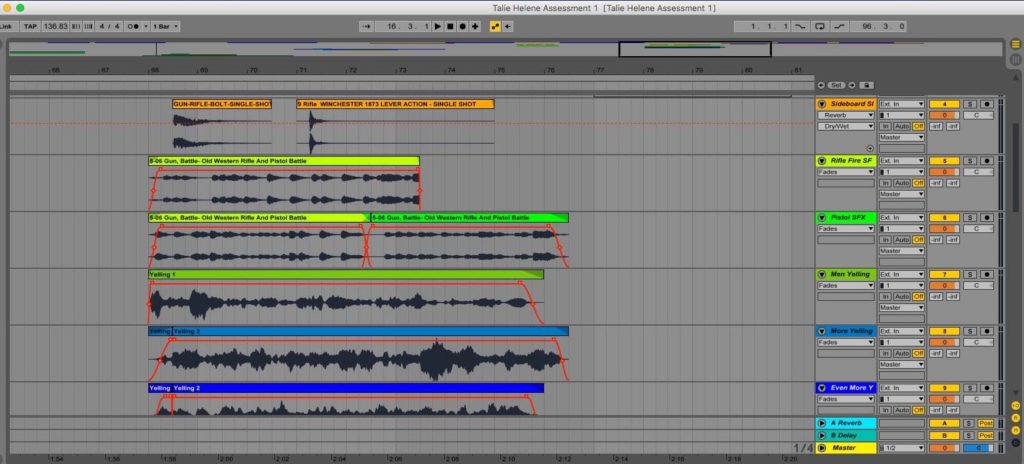
Ableton Screen Shot: Layered vocal elements of Men Shouting & Yelling location recordings, with SFX Library Gunshot Samples.
Both the Gun Shots (rifles and handguns) elements were created by layering numerous FX library samples, along with original sounds created by slamming the kitchen sideboard doors in my rental house – the regular cupboard and a metal enclosure which may have once housed ice (the house is circa 1920, and has many old fittings), recorded using a ZoomHN2 Handheld Digital Recorder with Built-In Microphone, with some reverb and EQ filtering.
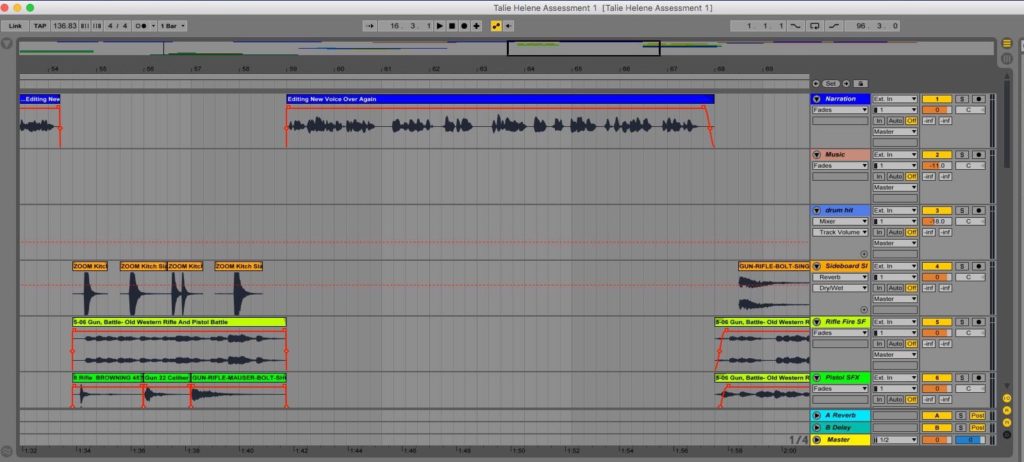
Ableton Screen Shot: Kitchen Sideboard Door Slams, layered with SFX Library Gunshot, and Voice Over element above.
I decided to do something a bit different than use the obvious steam train source of Puffing Billy. The Train Whistle was an original element I recorded on location at the Scoresby Steamfest using a Tascam DR-100MKII Linear PCM Recorder and a Sennheiser ME66/K6 Supercardiod Shotgun microphone. I was able to get very close to the source and ask the engine driver to pull the whistle for my recording.
The Steam Train Pistons Pumping was a combination of SFX Library Sample of a passing train with built-in panning effect and natural proximity effect, and original sounds layered together with volume automation, recorded on location on the grounds and in the engine sheds at Scoresby Steamfest (an annual event held by the Melbourne Steam Traction Engine Club), using a Tascam DR-100MKII Linear PCM Recorder and a Sennheiser ME66/K6 Supercardiod Shotgun microphone. I was able to get very close to many of the engines in the shed as they are fixed and quite safe to stand close to.
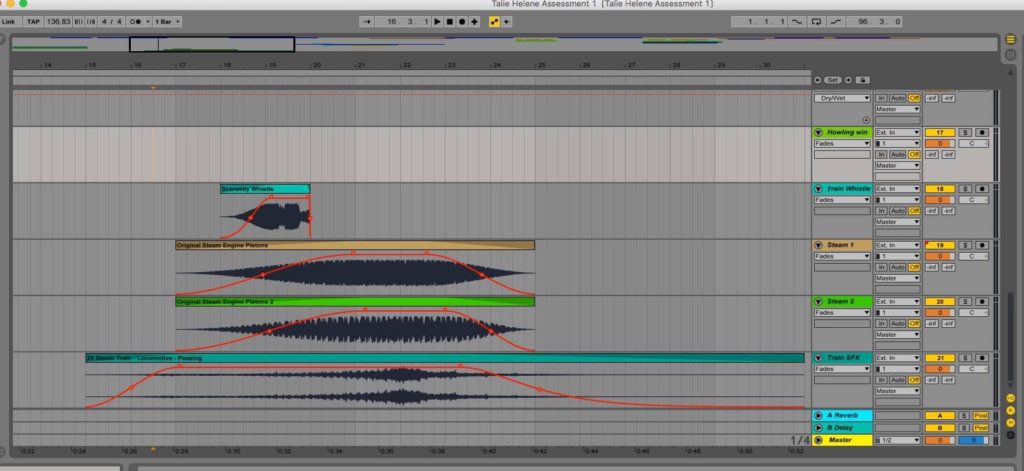
Ableton Session Screenshot: Layering of SFX Library Steam Train with two Steam Engine Location Recordings and a Steam Whistle Location Recording.
Due to the highly directional nature of the Sennheiser ME66/K6, it was possible to record sounds at SteamFest that were in close proximity to other loud sounds, as the directionality excluded a great deal of spill. For safety reasons I had the “auto level” function engaged at all times on the Tascam DR-100MKII Linear PCM Recorder, as I was monitoring with fully enclosed headphones and some of the sound sources were extremely loud, while others were not. The most problematic sources of spill were the PA announcements and the amplified country music artists at the market stage, who intruded on the vintage sound sources and were less directional due to amplification and speaker placement.
Processing, Editing & Mixing
I used three Digital Audio Workstation (DAW) environments for various tasks in this project. I recorded and edited the voice overs in Nuendo 8. I further edited the male voice over into element portions, and edited long location recordings and foley recordings to trim to required elements only in Pro Tools 12.
All audio elements were placed in Ableton Live 9. Some effects processing, and automation (panning, levels) was applied in Ableton.
I found in general my skills in Ableton Live 9 are very “newb”, and I had a lot of problems with not being familiar with Ableton specific features (such as Warp), as well as generally navigating and using the DAW. I still feel I have a poor grasp of the creative capacity and basic features of Ableton Live 9, which is why I applied (and was accepted) to attend the Operator short course in Ableton for women, trans and NGC people being held at Arts Centre Melbourne later this month; it is my hope that over the six weeks intro level course focused completely on Ableton operation, I will get the skills to go forward and make a more truly creative and competent use of Ableton in higher education studies.
Finished Project
You can listen to an MP3 of the finished Audio Tour here, in all its dubious glory. IMHO it needs to be re-balanced, as it had to be rough mixed in cans in Maclab during an arrangement class presentation, as the Ableton Edit Suites with Adam monitors were not functional, with Ableton not registered.
MP3: Audio Tour Project:
Ciao! Ciao!
Please feel free to leave a comment on this Blog Post. Thank You for labouring through reading or skimming this “virtual” Project Presentation. Now go outside and get some Vitamin D!
References
| ↑1, ↑2, ↑3 | Assessment 1 BRIEF, Created by Greg O’Shea, Martin Koszolko, February 2016, @Melbourne Polytechnic 2017. |
|---|---|
| ↑4 | https://www.neumann.com/?lang=en&id=current_microphones&cid=m149_description |
| ↑5 | Giang, Vivien. ‘How Unconscious Bias Is Affecting Our Ability To Listen’ Fast Company, 2016. https://www.fastcompany.com/3063218/how-unconscious-bias-is-affecting-our-ability-to-listen |
| ↑6 | https://en-us.sennheiser.com/directional-microphone-shotgun-film-broadcast-me-66 |




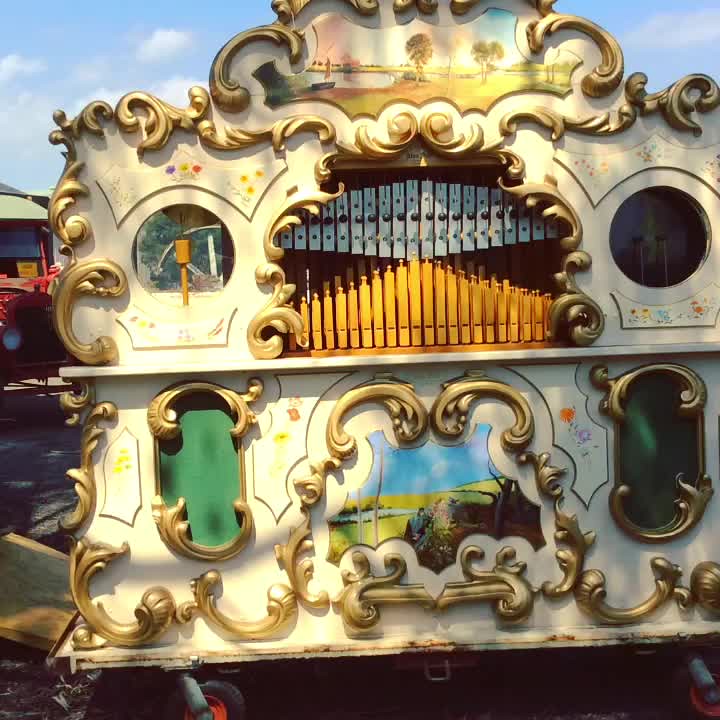
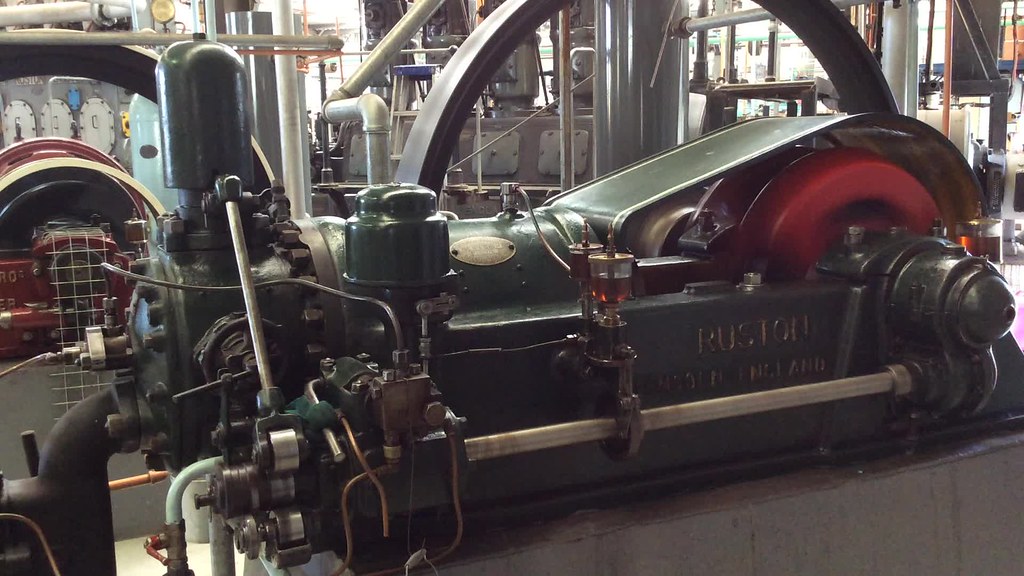
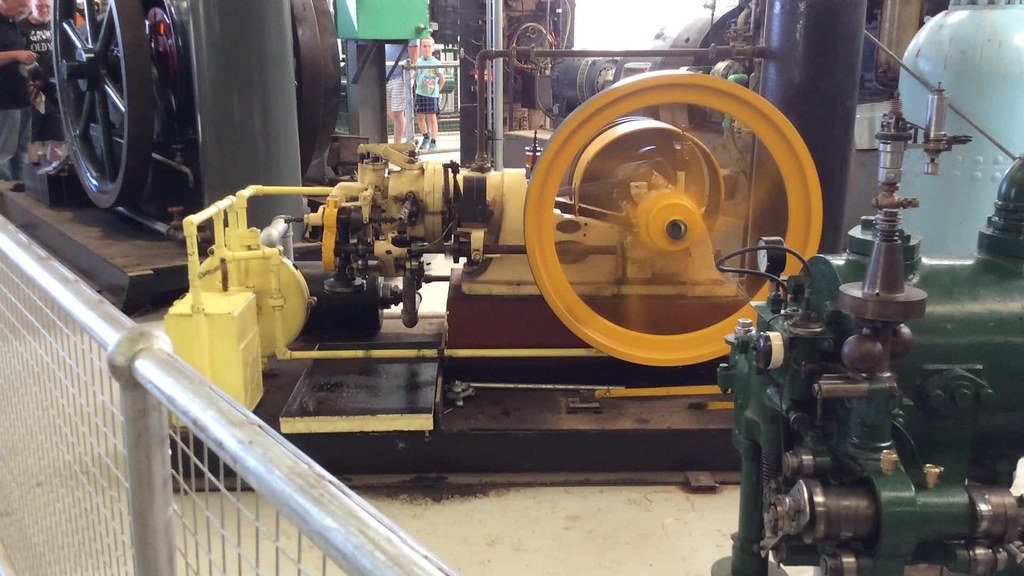
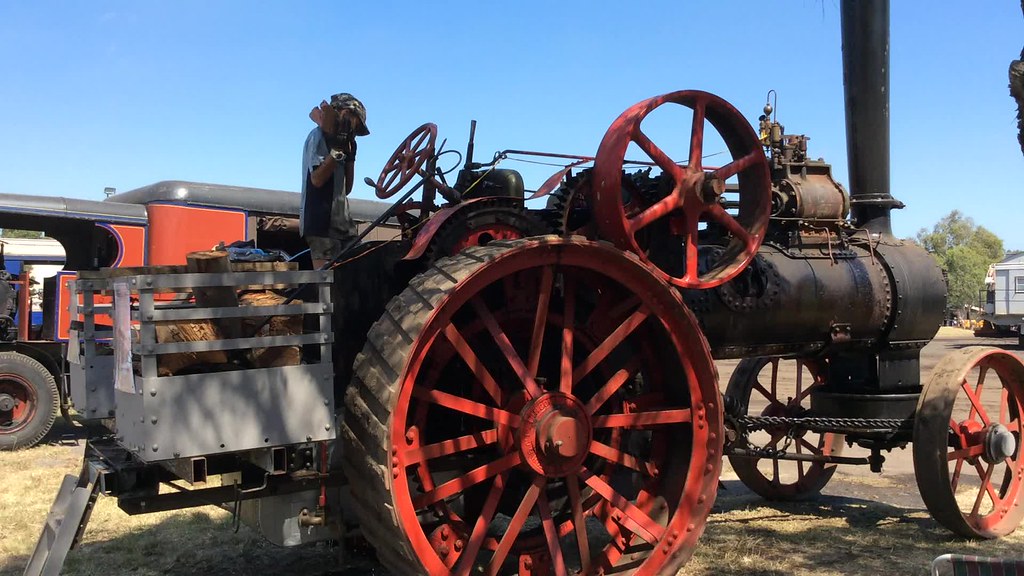
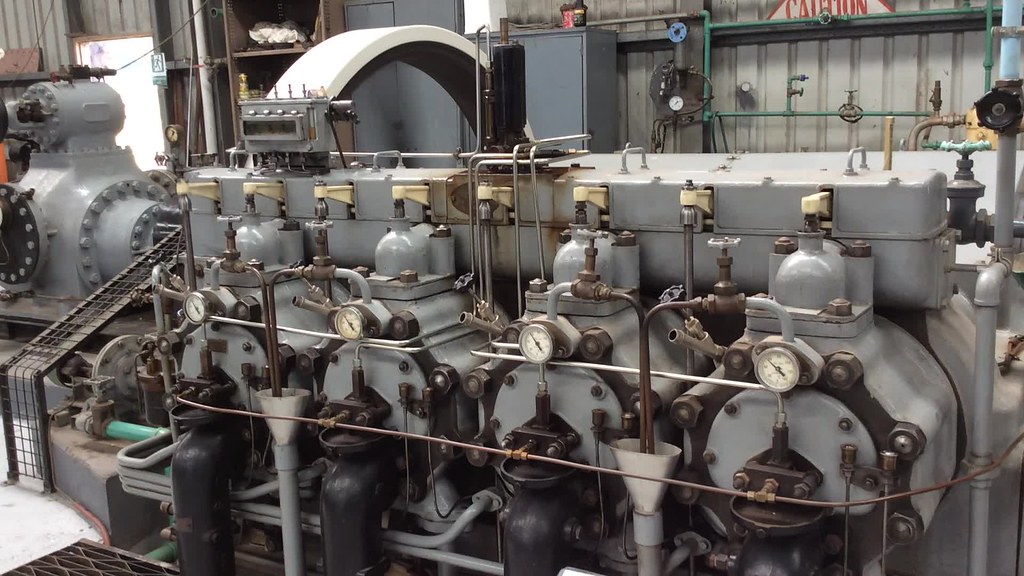
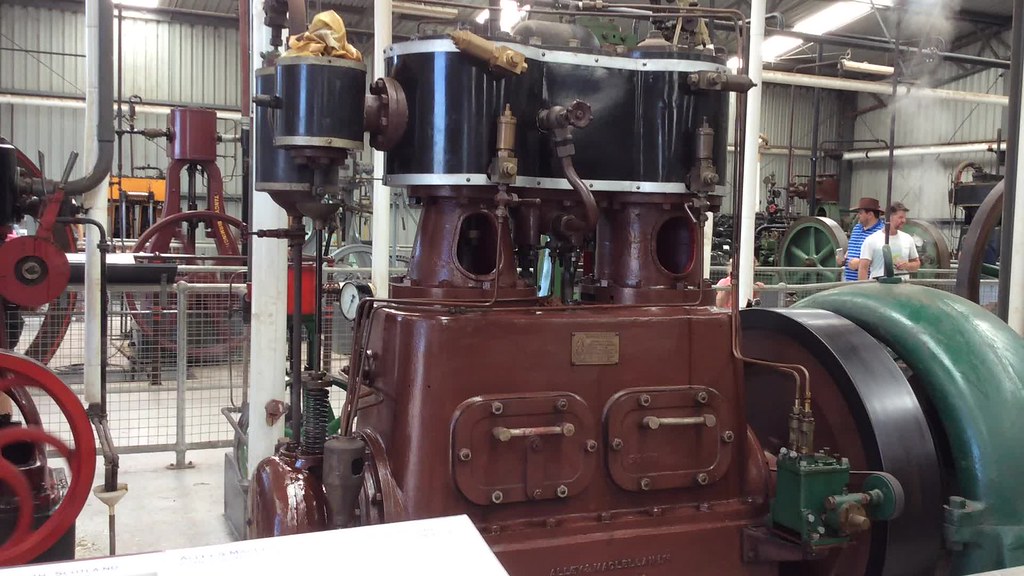


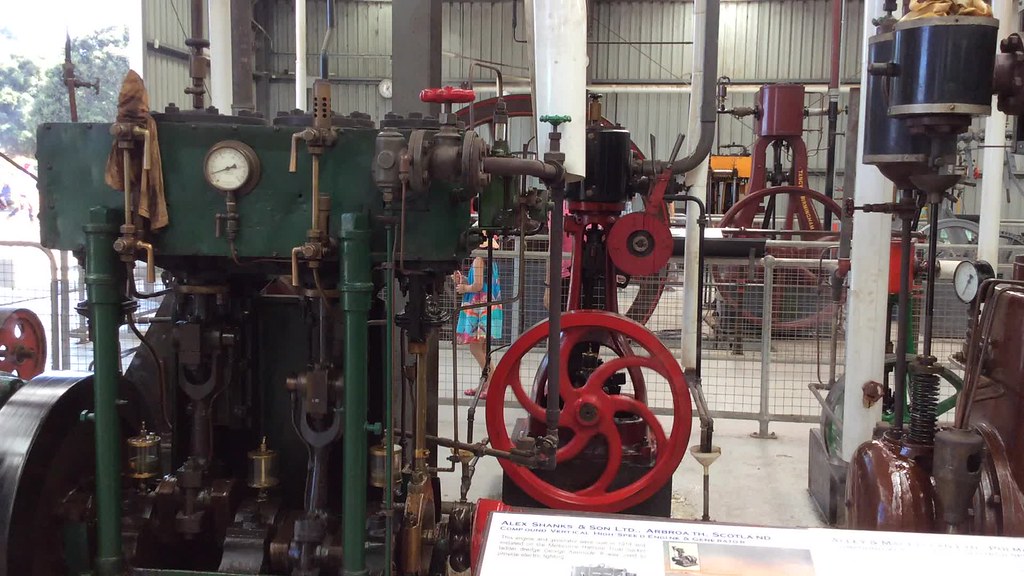
 You can find out more about my creative activities at
You can find out more about my creative activities at 
Recent Comments